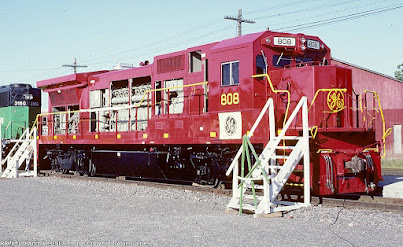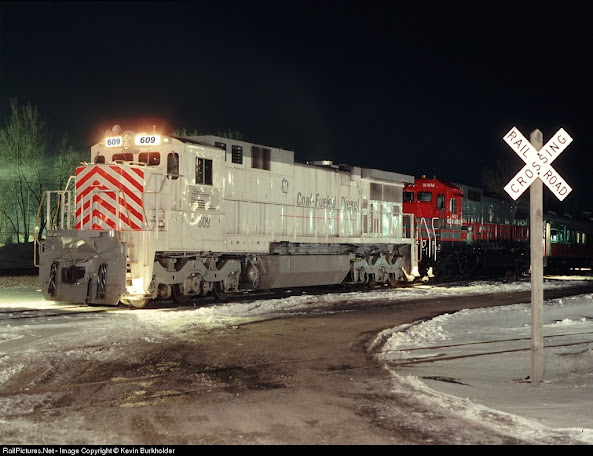 |
| A promotional GE paper depicting the C30-7A, a model unique to Conrail. Note that this paper describes the locomotive as having 3100 horsepower. |
General Electric's locomotive catalog had a constantly changing, very comprehensive naming system designed to differentiate every model at a glance without having to see the model. Every part of their naming convention was specially designed to differentiate different models, and allow for simplicity of naming and discussion... Except for one example: the "New Series".
"New Series" is a name GE used to describe not one, not two, but three different lines of locomotives built between 1976 and 1986. Worse still, sometimes GE's own numbering convention fails their equipment - see the above Conrail C30-7A having 3100 horsepower. In this post I hope to discuss all of the "New Series" by catalog and by model, to hopefully provide a differentiator between the three catalogs.
NEW SERIES - 1977
 |
| The admittedly undescriptive cover of a 1977 New Series operating manual. |
Despite being called the 1977 New Series, this line of locomotives was actually introduced in 1976. The 1977 New Series was a line of FRA clean cab complying replacements to the Universal line, including a handful of improvements to the ergonomics of the locomotive. Despite carbody changes and minor improvements across the board, these locomotives were largely identical to their Universal counterparts. Of note is that GE provided a direct replacement to every then-cataloged Universal in 1976.
4 AXLE
- B18-7 (UNBUILT) - Direct replacement for the U18B. The only model in the entire domestic series other than the U18B and U18BT (unbuilt) to include the FDL8.
- B23-7 - Direct replacement for the U23B. Used the FDL12.
- B28-7 (UNBUILT) - A new model for this line. Would have used the FDL12.
- B30-7 - Direct replacement for the U30B. Used the FDL16.
- B33-7 (UNBUILT) - Direct replacement for the U33B. Would have used the FDL16.
- B36-7 (UNBUILT)* - Direct replacement for the U36B. This is not the same locomotive as the B36-7 covered later on in this post. Would have used the FDL16.
*SSW's preproduction B36-7's technically count as original B36-7's as they are on the original 1977 revision 4 axle frame. I hesitate to call these New Series B36-7's largely due to their prototype status and otherwise functional identity as later B36-7's, however.
6 AXLE
- C23-7 (UNBUILT) - Direct replacement for the U23C. Would have used the FDL12.
- C28-7 (UNBUILT) - A new model for this line. Would have used the FDL12.
- C30-7 - Direct replacement for the U30C. Used the FDL16.
- C33-7 (UNBUILT) - Direct replacement for the U33C. Would have used the FDL16.
- C36-7 - Direct replacement for the U36C. This is not the same locomotive as the C36-7 covered later on in this post. Used the FDL16; only ordered by NdeM and Hamersley Iron.
The 1977 New Series was very comprehensive in its catalog, however the lack of deviation from standard horsepower brackets (the only 1977 New Series' built were B23-7's, B30-7's, and C30-7's) is apparent. Most railroads were purchasing line haul drag power in the C30-7 or road freight power in the B23-7 and B30-7. Do note the B36-7 and C36-7 in this line; they are functionally different from the later built models covered in the next section of this article, and the B28-7 and C28-7, both offered as more fuel efficient V12 models of the B30-7 and C30-7. While neither would be built, they would be iterated on further in the next catalog iteration in 1980.
NEW SERIES 7 - 1980
 |
| The cover of a 1980 revision Series 7 manual. Note the added 7 to the New Series moniker. |
The next catalog upgrade from GE came in 1980 with the "New Series 7". GE shortened the 1977 New Series name down to only the decade digit, differentiating these locomotives as 1970's designs. Unlike the 1977 New Series, New Series 7 actually included new models with major upgrades and improvements. GE also trimmed away the catalog down to only the most popular models.
4 AXLE
- B23-7 - Carried over from the 1977 New Series catalog with no major changes. Used the FDL12.
- B30-7A - A new model for this series. Intended to replace the B30-7, however both were offered concurrently. Used the FDL12.
- B30-7 - Carried over from the 1977 New Series catalog with no major changes. Used the FDL16.
- B36-7 - A new model for this series. Used the FDL16.
6 AXLE
- C30-7A - A new model for this series. Intended to replace the C30-7, however both were offered concurrently. Used the FDL12.
- C30-7 - Carried over from the 1977 New Series catalog with no major changes. Used the FDL16.
- C36-7 - A new model for this series. Used the FDL16.
GE's apparent laser focus with the New Series 7 into fuel efficiency and raw power seems apparent on paper, but is much more apparent in reality, as the horsepower numbers listed in these locomotives are very flexible depending on era. As an example, a C36-7 built in 1980 is most likely 3600 horsepower, however much later production units (such as Missouri Pacific's) are 3750. The 3000 horsepower V12 locomotives are descended from the unbuilt 2750 horsepower B28-7 and C28-7, and can be 3100 horsepower if ordered late enough.
The new models in this catalog are unique in that they carry GE's GTA-24 alternator (with the exception of the C30-7A) and SENTRY creep control, allowing for greatly improved low speed performance. This is in stark contrast to the 1977 New Series' 3600 horsepower models, which would have used performance control and power reduction in place of advanced creep control.
NEW SERIES 8 - 1984
 |
| The cover of GE's Series 8 Handbook. |
The last catalog iteration to use the New Series moniker was the 1984 series, dubbed New Series 8. Very few people in enthusiast circles describe this series as such, however; the "Classic Dash 8" has stuck far better. Truthfully, Classic Dash 8 is a better descriptor, as these models are functionally proto-Dash 8's in technology and performance.
It should be noted that, unlike the change between 1977 and 1980, the New Series 7 was still offered alongside the New Series 8. The last New Series 7's were built in 1986 (an order of C30-7's for NdeM), and although none were built beyond then, paper material suggests that they were still available as late as 1991.
4 AXLE
- B23-8 (UNBUILT) - A direct replacement for the B23-7. Would have used the FDL12.
- B32-8 - A direct replacement for the B30-7A. Used the FDL12.
- B39-8 - A direct replacement for the B36-7. Used the FDL16.
6 AXLE
- C32-8 - A direct replacement for the C30-7A. Used the FDL12.
- C39-8 - A direct replacement for the C36-7. Used the FDL16.
The catalog has been streamlined even further here, trimming away the V16 3000 horsepower offerings and totally replacing them with V12 equivalents. This line of locomotives are also the first to include GE's GMG series alternators, which would continue to be built by GE well into the era of the Evolution line.
In early 1987, GE
introduced an iterative upgrade to the New Series 8 which massively
overhauled the carbody and made minor changes to the locomotive's
internal layout. Despite the massive changes between 1986 production
Series 8's and 1987 production Series 8's, GE did not differentiate
between them. Enthusiast circles have dubbed these models as "Enhanced",
placing an E at the end of their names, however these are not official.
Only two models of Series 8 ever received "Enhanced" variants: B39-8's
built for lease service to BN and the last NS order of C39-8's.
DASH 8 - 1987
 |
GE promotional photograph of Conrail 6050, the class unit of their Dash 8-40CW fleet. Conrail classified these units as C40-8W. |
GE introduced the Series 8's replacement later in 1987, with the first Dash 8's appearing on the market. Direct replacements for all models (minus the B23-8) were immediately available, with the V16 equipped models receiving a minor horsepower increase to 4000. GE also introduced a new naming convention with this catalog, dropping New Series and replacing it with Dash and the decade of introduction (GE was already in the planning stages for the Dash 9 at the time of the Dash 8's introduction).
- Dash 8-32B - A direct replacement for the B32-8. Used the FDL12.
- Dash 8-40B - A direct replacement for the B39-8. Used the FDL16.
- Dash 8-32C (UNBUILT) - A direct replacement for the C32-8. Would have used the FDL12.
- Dash 8-40C - A direct replacement for the C39-8. Used the FDL16.
Widecab variants came later on, with the first widecab 6 axle appearing in 1989 for UP and the first widecab 4 axle appearing in 1990 for ATSF.
- Dash 8-40BW - A widecab alternative to the Dash 8-40B.
- Dash 8-40CW - A widecab alternative to the Dash 8-40C.
Other special order models under the Dash 8 umbrella include:
- Dash 8-32BWH - HEP equipped V12 powered 3200 horsepower widecab passenger locomotive. Special order for Amtrak.
- Dash 8-40BP - The Genesis! Specifically the 4000 horsepower model. Also known as P40DC, GENESIS Type 1, and AMD-103. Special order for Amtrak.
- Dash 8-42BP - The second generation Genesis. Also known as the P42DC and GENESIS Type II.
- Dash 8-32BP-DM - Third rail capable AC traction motor equipped V12 powered 3200 horsepower Genesis. Also known as the P32AC-DM. Purchased by Amtrak and Metro-North.
- Dash 8-40CM - Full width cowl carbody Dofasco high adhesion truck equipped Dash 8-40C. Made for the Canadian market; purchased by BC Rail and Canadian National.
I originally omitted the P42DC from this list as I had not seen it referred to with a Dash 8 moniker. I have since been proven wrong; it is referred to as a Dash 8-42BP in parts manuals.
Much later in the life of the Dash 8, GE offered horsepower upgrades to 4135 horsepower instead of 4000, birthing the following models. The upgrade could also be done to previous Dash 8's.
- Dash 8-41CW - Factory optional 4135 horsepower upgrade for the Dash 8-40CW. Purchased by ATSF and UP.
- Dash 8-44CW - 4390 horsepower upgrade for the Dash 8-40CW. CSX exclusive.
Beyond the Dash 8, GE's naming convention becomes muddy, and I hope to cover it in a future post. For now, though, enjoy this descriptive catalog of GE's diesel locomotives built between 1976 and 1993.













































